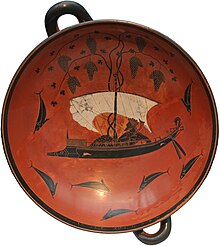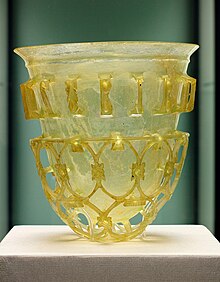State collections of antiquities

The State Collections of Antiquities in the Munich Art Area , formerly the Museum of Ancient Cabaret , are one of the largest collections of antiquities in Germany for Greek , Etruscan and Roman art .
The building
The building in which the antique collections are located today was built between 1838 and 1848 on behalf of King Ludwig I by Georg Friedrich Ziebland in the style of a Corinthian temple on Königsplatz . In the center of the gable field which is Bavaria , as Mittelakroter of the gable roof, however graces Phoenix construction, operation at high staircase under the portico rises above the square. The building complemented the classical forum created by architect Leo von Klenze from 1815 on Königsplatz and initially served under the name Kgl. Art exhibition building on Königsplatz as an art and industrial exhibition building. At the same time, the St. Boniface monastery was built on the south side of the building .
The building housed the royal antiquarium from 1869 to 1872, and the Munich Secession moved in from 1898 to 1912 . From 1919 the New State Gallery was housed in the building. After the destruction in World War II , the building that had previously been gutted was reopened as the Staatliche Antikensammlungen in 1967.
The history of the collection
The collection goes back to the Wittelsbachers ' collection of antiquities , particularly the collections of King Ludwig I. In 1831 his agent Johann Martin von Wagner acquired pottery from the excavation in Vulci , his agent Friedrich von Thiersch bought antique art from the estate of Lucien Bonaparte . The king acquired gold jewelry from Caroline Murat's possession , Etruscan bronze art from the excavations in Perugia , Etruscan gold jewelry from the Candelori brothers and Greek terracotta from southern Italy. Otto Jahn's collection of vases was cataloged from 1853 to 1854 . After the king's death in 1868, his collection was combined with the Wittelsbach Collection of Antiquities, which went back to Duke Albrecht V. The exhibits were on display until 1872 in the Antiquarium of the Residenz and in the Hofgarten galleries , then in the basement of the Neue Pinakothek .
The Bavarian Association of Friends of Art , which was co-founded by Crown Prince Rupprecht of Bavaria in 1905 , made numerous acquisitions for the collection. The holdings were later enriched by private foundations and bequests, in particular the collections of Paul Arndt (1908), James Loeb (1933) and Hans von Schoen (1964). In addition to antique ceramics, these important collections included small-format antique objects, glass and bronze art, as well as terracotta and gold jewelry . The stock of Etruscan ceramics that was housed in the depot of the New Pinakothek, which was destroyed by bombs, was hit hardest by the Second World War .
The collection
Exhibits from the collection of Greek vases and ceramics as well as from other collections including Etruscan and Roman art, in particular numerous terracottas, bronzes, gold jewelry, glasses, portraits, gems and coins as well as reliefs are on display. Next also already Cycladic Art on display.
Ceramics
The collection contains pottery from all epochs of the Greco-Roman period, from the Mycenaean jug from the 13th century BC. Through the vases from the geometric period (approx. 900–700 BC), archaic period (approx. 700–480) and classical times (approx. 500 / 480–323 BC) to the ceramics of Hellenism (323–146 BC), the Etruscans and ancient Rome.
The collection of Greek vases is one of the most important in the world, it contains ceramics from the most important Greek potters and painters such as the Amasis Painter , Exekias , Archikles , Glaukytes , the Penthesilea Painter , the Andokides Painter , Oltos , Cleophon , Phintias , Euphronios , Euthymides , Epiktetos , the Pan Painter , the Berlin Painter , Hieron , Makron , Duris , the Brygos Painter , the Achelous Painter and Lydos . The most important potters and vase painters had signed their vessels like works of art. Numerous masterpieces such as the belly amphora by Andokides painter and the Dionysus bowl by Exekias are exhibited in the collections of antiquities.
Exemplary statuettes made of terracotta in the collection include the so-called Ajar Eros , the seated boy , the Standing woman and standing youth . One of the world's best-preserved ancient terracotta figures is The Beautiful . It was made in the early 3rd century BC. Created and found near Athens.
One of the masterpieces of Etruscan art is a head vessel depicting the Etruscan death demon Charun (400-350 BC)
Bronzes
The bronze statuette Goddess of Beauty and Love is a masterpiece of Hellenistic bronze art and dates from around 100 BC. It was found in Beroea in the northern Greek region of Macedonia.
Glasses
The famous diatret glass beaker from Cologne (around 400), which the city gave to King Ludwig I as a thank you for his work in completing the Cologne Cathedral , still shows its Latin inscription: BIBE MULTIS ANNIS (drink for many years to come).
Jewelry and gems
Significant exhibits of antique jewelry are in particular the Greek-Italian gold wreath from Armento from the 4th century BC as well as Greek earrings, gold chains and thigh bands from the same era. The gold diadem from the Black Sea comes from the Crimea (approx. 150 BC).
The State Collection of Antiquities also includes the Helmut Hansmann (1924–1996) collection with around 700 antique and modern gems .
Other material groups
The painted wooden panel of a mummy portrait, which was found during excavations in Hawara in the Fayum oasis in 1892, is one of the most beautiful and qualitatively best ancient mummy portraits. Made around 140, it shows a young man from the upper class of Egypt during the imperial era.
Antiquity in the art area
The holdings of the antique collections are supplemented by the antique sculptures in the Glyptothek . Greco-Roman art, which has emerged in Egypt since the Hellenistic conquest, is also in the State Museum of Egyptian Art . Roman art from southern Germany, on the other hand, is not in the art area, but in the State Archaeological Collection in Lehel. The State Collection of Antiquities in the Munich Center for Ancient Worlds is closely linked to university and non-university research institutes relating to antiquity.
Directorate and branch
The management of the antique collections is located in the house of the cultural institutes . Since May 1, 2011, the director succeeds Raimund Wünsche Florian Knauß .
A branch of the Staatliche Antikensammlungen is located in the Pompejanum in Aschaffenburg.
Special exhibitions (selection)
- Gold of the Scythians from the Leningrad Hermitage (1984)
- Art of the bowl - culture of drinking (1990)
- The Myth of Troy: An exhibition on Munich's Königsplatz (July 19, 2006 - January 31, 2008)
- Strong Women (June 4, 2008 - August 2, 2009)
Web links
- Official website of the State Collections of Antiquities in Munich
- Florian Knauß : From the Kunstkammer to the State Collection. History and perspectives of the Munich antique collections . Video from Winckelmann's lecture 2012 of the Archaeological Society of Berlin
Individual evidence
- ↑ see cover sheet of exhibition catalog X. Exhibition of the Munich Secession. The German Association of Artists , Munich 1904
- ↑ Participating institutes in the Munich Center for Ancient Worlds. Retrieved November 12, 2018 .
- ^ Homepage Bavarian State Government Press release from April 8, 2011 ( Memento from August 8, 2014 in the Internet Archive )
Coordinates: 48 ° 8 ′ 42 " N , 11 ° 33 ′ 53" E


